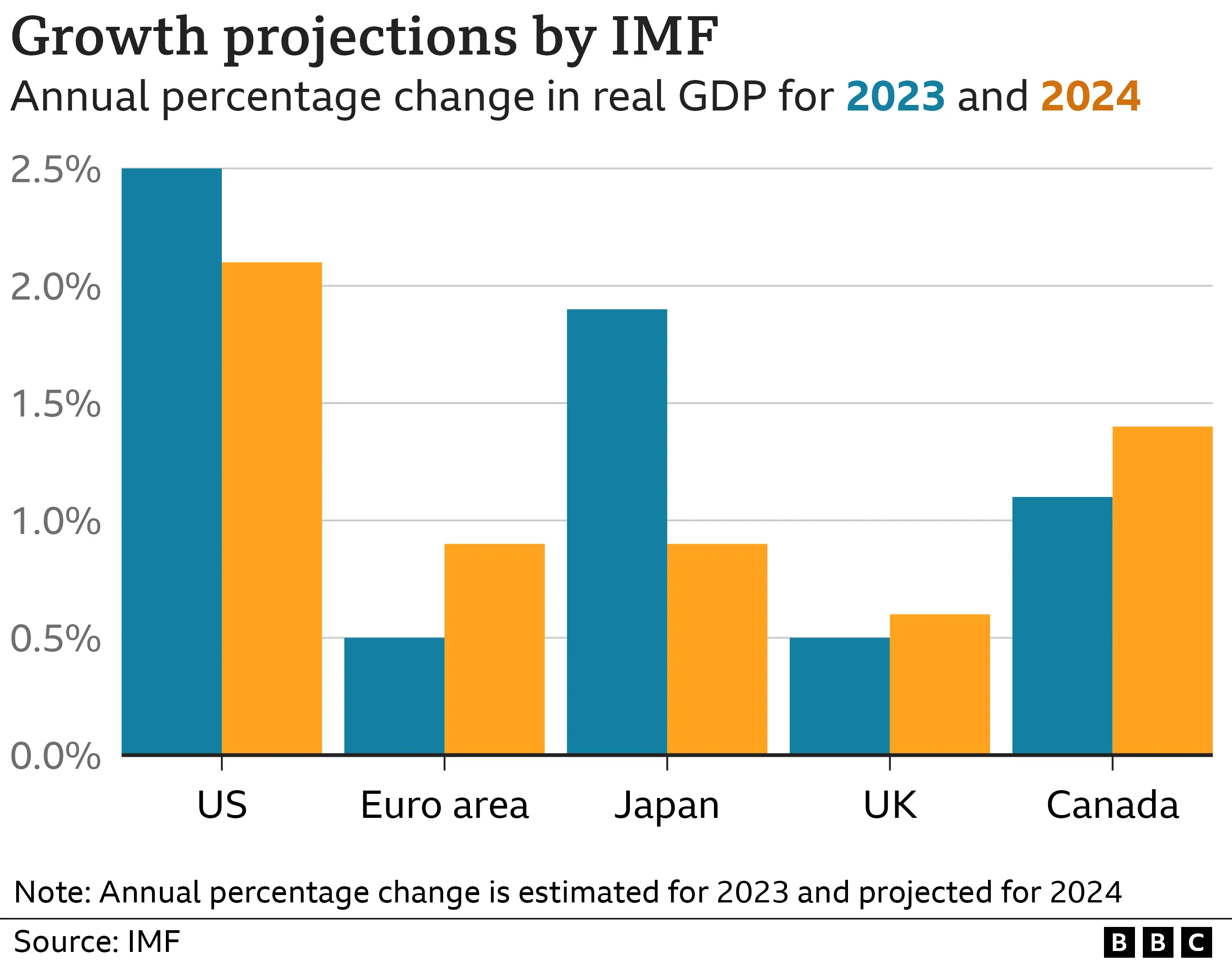By Erin Delmore, New York business correspondent
 Getty Images
Getty ImagesWhile countries around the world have struggled to recover from the economic setbacks brought on by the pandemic, one has emerged particularly strong.
With a fast-growing economy, a strong labour market and falling inflation, the US has outpaced its counterparts in Europe and elsewhere.
In terms of GDP, it posted a 3.3% gain in the fourth quarter of 2023, far exceeding economists’ expectations of 2%.
That put the US at 2.5% over the course of the year, outpacing all other advanced economies and on track to do so again in 2024.
“The US is holding up much better than other countries,” said Ryan Sweet, Chief US Economist, Oxford Economics. “It seems like the engine of the US economy continues to hum along where it’s sputtering in other nations.”

Experts say that there are several reasons why the US is outperforming other nations.
1. Pouring trillions into the economy
When the Covid-19 pandemic slowed in-person work and social life to a halt, countries had to grapple with how to support their stuck-at-home citizenry – including many who lost their jobs or couldn’t work.
In March 2020, Congress rushed to pass a $2.2tn economic stimulus bill that sent cash into the pockets of American workers, families, and businesses. Two more pieces of legislation followed to keep small businesses afloat and workforces employed.
This was the largest influx of federal money into the US economy in history. Some $5tn flowed to everyone from individuals making an extra $600 in weekly unemployment benefits to state and local transit agencies strapped for cash without commuters.
“I think there was a whole generation of policymakers that came out of 2008 and 2009 with the lesson that if you don’t go big and go bold, the problems last for a long time,” said Aaron Terrazas, chief economist at Glassdoor.
“If you’re tentative, you prolong the pain. So I think that’s one reason why the fiscal response was so much more forceful this time.”
That stimulus is still being credited with sustaining consumer spending, which accounts for 70% of economic activity. That capacity to spend despite high inflation has been a buoy.
 Getty Images
Getty ImagesSome of the money put into households’ pockets ended up in excess savings, said Ryan Sweet, a war chest for Americans to tap into when they need it.
The size of the US rescue deal dwarfed what other countries did, although some like Japan, Germany and Canada also went big.
European countries have a more robust social safety net than the US and were able to adapt existing programmes without increasing spending. But this short-term advantage could not make up for the huge gap in stimulus size.
2. A flexible jobs market
High inflation has been a painful experience for many Americans and has shaped their view of how the economy is faring. But a strong jobs market has helped disposable income, which is the engine behind consumer spending.
The unemployment rate in the US has been below 4% since February 2022, which is on a par with historic lows. And while prices climbed steeply, real wages have risen too. Low-income households have seen some of the strongest real wage growth.
The US has also enjoyed a productivity spike in 2023, growing at its fastest pace in years.
Julia Pollak, chief economist at ZipRecruiter, points to the flexible labour laws which allowed companies to slash workforces at the start of the pandemic. This produced short-term pain for workers but allowed companies to adapt to the moment and invest in new technologies.
She cited the example of hotels, which laid off workers and haven’t hired back to pre-pandemic levels.
“They’ve simply changed a lot. They’ve introduced self-checkouts and mobile check-in technology. They’ve reduced the frequency of room cleaning, they’ve eliminated room service, because now customers tend to prefer to use Uber Eats anyway, and pick up orders and deliveries.”
Hotels have become lighter and leaner and less personnel intensive, she said, a shift that meant they lived on which, in the longer term, benefits workers.
 Getty Images
Getty ImagesThe US enjoys another advantage – an ability to resupply its labour market, especially through immigration at a time when the retirement of the baby boomer generation has slowed population growth.
The European approach favoured paying companies to keep workers on their payrolls when lockdowns crippled businesses. The UK furlough scheme paid employees 80% of their wages and lasted more than 18 months.
The US had more severe unemployment as a result but laid-off American workers were eligible for newly-expanded unemployment benefits, which sent cash directly into pockets.
3. Energy (in)dependence
The US is a net exporter of energy and experts say that’s helped the US economy’s strength.
When Russia invaded Ukraine in February 2022 and energy prices soared, Europe absorbed the impact much more than the US. Germany, a major European manufacturing hub, imported much of its natural gas from Russia via its Nord Stream pipeline. Its productivity took a hit.
Higher energy prices pushed up inflation in Europe, in what experts called a “double-shock” – the pandemic and then Ukraine.
The impact of the Ukraine war on energy prices was a lot worse in Europe than in the US, said Ben Westmore, who oversees surveillance of the US economy for the OECD.
Gas prices in Europe between early 2021 and 2022 shot up by something close to 20%, he says, whereas in the US, it was only 3-4%.
He pointed out that European countries have seen not only a bigger increase in prices, but also a greater propensity for businesses to pass them on to consumers.
“Both of these factors have helped U.S. inflation moderate to a faster extent than in many countries, especially Europe,” he said.

More on the global economy



